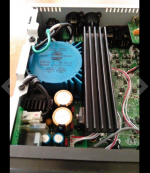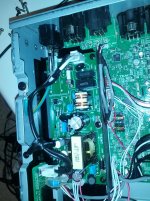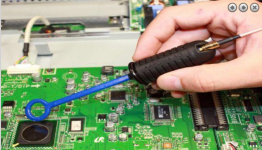No. Read what I actually said. You stop a follower from generating RF by adding a resistor. The resistor is not a filter to remove RF already generated, but a stopper - it stops the oscillation by overcoming the negative resistance at the output.ginetto61 said:You cannot stop a follower from generating RF because it is its nature.
You really must try understanding, and stop looking for recipes.
Your EMC starter...
http://www.hottconsultants.com/pdf_files/dipoles-1.pdf
http://www.hottconsultants.com/pdf_files/dipoles-2.PDF
http://www.hottconsultants.com/pdf_files/dipoles-3.PDF
Add Ralph Morrison to your list of required reading...
Amazon.co.uk: Ralph Morrison: Books, Biogs, Audiobooks, Discussions
The fields of electronics is a good starter....
I have as I said previously been learning about EMC from a practical (and academic)viewpoint for 30+ years, don't expect enlightenment overnight... The practical side is doing layouts and EVERY layout I do being tested quite often to the extreme for EMC, a lot of the stuff I play with has far tighter requirements than consumer products...
Hi and thanks a lot again for your kind and valuable support.
But even without reading i am afraid this topic is so beyond my ability to understand. This is for smart people who actually want to design smps.
I am only a curious and limited end user.
Honestly i have tried to follow the threads with discussions about design in general and always very soon i have got lost completely. It is just too difficult.
So i decided to follow the threads on modifications of already existing units where the aim is to solve issues or improve performances.
And this is one case in which a guy has been able to spot the problem.
A smps that used outside the box is perfectly fine but when placed inside the box causes some noise.
Maybe it is also some cable too close to emitting parts on the smps that acts like and antenna and discharge the noise in the pcb ?
When i will have the am radio i will try to place its antenna close to each components and listen for the buzz.
I found a guy who has replaced the internal smps with a new linear one.
My ideal solution would be a internal regulations stage and an external mains voltage transformer.
I will try in the weekend to extract the smps and measure the Vout.
This unit is very little short than perfection.
Just this little noise issue
Thanks a lot again, gino
Attachments
Last edited:
Ginetto,
Please be careful with the radio. Plucking the extended metallic antenna into open devices is a big no- no!
In the suggested bands (medium and shortwave) anyway the external, telescopic antenna is not used - it is only for the FM bands.
And in general, this 'radio surway' method is at it's best when searching for 'offenders' on unit level. It has not enough good resolution for differentiating between small areas, parts in a circuit. Or rather, it's a border case.
So, keep the telescopic antenna in it's place, please. Move around, and rotate the radio as you wish, but not sticking the antenna inside. It's not giving extra benefits, and it's dangerous.
You will see, that just moving around will give already an impression what is going on.
Then, if the result is (relative) silence -- it can well be!
Not all smps are made the same; well engineered ones can be surprisingly innocent with respect to EMI/RFI.
Don't forget that the one in the computer (well sealed) is designed to provide dozen's of amperes for the motherboard; in your case the circuits in your dac are not at all the same consumption level.
So as to 'calibrate' your device and method, have a look at your LCD screens;
I haven't encountered a silent one, yet..
One can also "patrol" above the surface of a laptop (even better with the screen 'off') - aha, this zone is rather active -- wow, this could be the hard disk, really?!
Ciao, George
Please be careful with the radio. Plucking the extended metallic antenna into open devices is a big no- no!
In the suggested bands (medium and shortwave) anyway the external, telescopic antenna is not used - it is only for the FM bands.
And in general, this 'radio surway' method is at it's best when searching for 'offenders' on unit level. It has not enough good resolution for differentiating between small areas, parts in a circuit. Or rather, it's a border case.
So, keep the telescopic antenna in it's place, please. Move around, and rotate the radio as you wish, but not sticking the antenna inside. It's not giving extra benefits, and it's dangerous.
You will see, that just moving around will give already an impression what is going on.
Then, if the result is (relative) silence -- it can well be!
Not all smps are made the same; well engineered ones can be surprisingly innocent with respect to EMI/RFI.
Don't forget that the one in the computer (well sealed) is designed to provide dozen's of amperes for the motherboard; in your case the circuits in your dac are not at all the same consumption level.
So as to 'calibrate' your device and method, have a look at your LCD screens;
I haven't encountered a silent one, yet..
One can also "patrol" above the surface of a laptop (even better with the screen 'off') - aha, this zone is rather active -- wow, this could be the hard disk, really?!
Ciao, George
What SMPS, like all circuitry there are good examples and bad
Hi and yes of course. But replacing the original smps with the other new linear same noise base line and absolutely no bumps. Perfect.
I wonder where i can buy a service manual of this Tascam unit.
That would be very helpful indeed.
Thanks and regards, gino
Ginetto,
Please be careful with the radio. Plucking the extended metallic antenna into open devices is a big no- no!
Hi again ! even if i place some isolant tapes on it ? that shoud avoid any short circuit. I asked this because i see a probe (plastic covered by the way) to be connected to a scope i think.
In the suggested bands (medium and shortwave) anyway the external, telescopic antenna is not used - it is only for the FM bands.
i did not know this
And in general, this 'radio surway' method is at it's best when searching for 'offenders' on unit level.
It has not enough good resolution for differentiating between small areas, parts in a circuit. Or rather, it's a border case.
So, keep the telescopic antenna in it's place, please. Move around, and rotate the radio as you wish, but not sticking the antenna inside.
It's not giving extra benefits, and it's dangerous.
You will see, that just moving around will give already an impression what is going on.
Message received ! thanks a lot !
Then, if the result is (relative) silence -- it can well be!
Not all smps are made the same; well engineered ones can be surprisingly innocent with respect to EMI/RFI.
Don't forget that the one in the computer (well sealed) is designed to provide dozen's of amperes for the motherboard; in your case the circuits in your dac are not at all the same consumption level.
So as to 'calibrate' your device and method, have a look at your LCD screens;
I haven't encountered a silent one, yet..
One can also "patrol" above the surface of a laptop (even better with the screen 'off') - aha, this zone is rather active -- wow, this could be the hard disk, really?!
Ciao, George
asa i will receive it i will test anything around to get used to it.
However i have seen indeed some EMI Probe Sniffer
RENTAL: EMI Probe Sniffer Set; DC to 6 GHz for hire Measurement Rentals
very very expensive and also a scope is required.
Thanks a lot again.
regards, gino
P.S. found something
https://www.youtube.com/watch?v=uKk-ZaPrfYM
i have seen a very similar bump also here at 1:10 !!! so it is a recurrent issue with smps ?
I am now convinced that one day i will take the smps out. Inside they create only problems.
Attachments
Last edited:
That probe is for the magnetic field, and such things are actually fairly easy to make from a bit of semi rigid coax and a small screening box, but you really need a spectrum analyser to interpret the results, and like all tools they are only as good as the person using them.
You seem to be under the impression that if you can just find the right tool the measurements and their interpretation is a simple thing, NOT SO.
Also you seem to be obsessing about noise 100dB down and out of the audio band, I have to ask why you care about that noise (Any mic that has a response up there will be hearing the acoustic whistle from all kinds of phone chargers and other small switchmodes anyway, it is difficult to get away from the things).
Regards, Dan.
You seem to be under the impression that if you can just find the right tool the measurements and their interpretation is a simple thing, NOT SO.
Also you seem to be obsessing about noise 100dB down and out of the audio band, I have to ask why you care about that noise (Any mic that has a response up there will be hearing the acoustic whistle from all kinds of phone chargers and other small switchmodes anyway, it is difficult to get away from the things).
Regards, Dan.
That probe is for the magnetic field, and such things are actually fairly easy to make from a bit of semi rigid coax and a small screening box, but you really need a spectrum analyser to interpret the results, and like all tools they are only as good as the person using them.
Hi and thanks for confirming my impression that a complex and expensive analyzer is needed.
You seem to be under the impression that if you can just find the right tool the measurements and their interpretation is a simple thing, NOT SO.
I am not saying about fixing, only spotting. If i pass the probe on the pcb the signal on the scope or the buzz will vary in intensity the closer to the part that is emitting the EMI/RFI ... am i wrong ? so i could locate the origin of the disturbs. Fixing is out of question because i guess it involves design. But suppressing maybe ... for instance with those 3M sheets. I have seen people using them on transformers/coils and so on ...
They are not cheap at all by the way. Actually quite expensive.
So one solution could be to stick pieces of these sheets on the emitters.
Also you seem to be obsessing about noise 100dB down and out of the audio band, I have to ask why you care about that noise (Any mic that has a response up there will be hearing the acoustic whistle from all kinds of phone chargers and other small switchmodes anyway, it is difficult to get away from the things).
Regards, Dan
Dan, it is stronger than me. If it could not be possible to erase those ugly bumps or very expensive i would live with that. Instead i am sure that one day those bumps will go away.
If i fry the unit i will buy another one and try again.
Still for me it is an evidence of flawed design. There is no excuse for a bad measurements that could be avoided just with a simple different approach (external smps). Like many others actually do.
Thanks a lot again, gino
why worry about what you cant see or hear? If you used a microscope to examine all you touch and come in contact with you would be shocked. Do you want to turn into that certain character on 'Better Call Saul'?
Attachments
Last edited:
why worry about what you cant see or hear?
Hi ! sorry and all the very gifted designers here searching for the minimal distortion and ultra low noise ? are they all obsessed ? yes !
Again ... this is a slip in an already very nice design.
I am sure also easily fixable. For who knows what to do of course.
Moreover the fact that probes do exist for this kind of RFI sniffing shows that there is a need for this kind of test.
If you used a microscope to examine all you touch and come in contact with you would be shocked. Do you want to turn into that certain character on 'Better Call Saul' ?
I know that series ! i have watched it on netflix.
Again ... it is like climbing up to twenty meters from the top of a mountain
and then stop without reaching it.
Better ... it is like laying down a moquette not perfectly flat but with bumps .. you can walk on it anyway, but for sure it does not look very pretty.
regards, gino
that is your conclusion , is it correct?Moreover the fact that probes do exist for this kind of RFI sniffing shows that there is a need for this kind of test.
the ppl that are skilled in SMPS may tell you that radiated stuff is the least of concerns.
microscopes inform too, do you see normal ppl using them to clean up living areas?
Actually mostly those probes are used for pre compliance testing as a quick and relatively inexpensive way to check that your design will most likely pass the EMC tests for CE and FCC marking (Usually things like overly fast clock edges are a bigger concern then power supply radiating down near DC).
And no, when designing commercial gear, you nearly NEVER see a spec that says 'make it as good as possible', what you see is a spec that includes a target cost, some desired performance numbers and a desired ship date, you do not earn more points for massively beating the target spec (But you may get a bonus for massively beating the target BOM cost).
Certainly is the spec says internal power then you will not win any points for using a line lump, and if the spec says universal input supply, that pretty much forces you into going for a switcher, then you have pressure (Cost and Schedule) to use a common part that your company has already gotten thru safety and EMC approvals.
You have an overly rose tinted view of the design process for products in that class.
Regards, Dan.
And no, when designing commercial gear, you nearly NEVER see a spec that says 'make it as good as possible', what you see is a spec that includes a target cost, some desired performance numbers and a desired ship date, you do not earn more points for massively beating the target spec (But you may get a bonus for massively beating the target BOM cost).
Certainly is the spec says internal power then you will not win any points for using a line lump, and if the spec says universal input supply, that pretty much forces you into going for a switcher, then you have pressure (Cost and Schedule) to use a common part that your company has already gotten thru safety and EMC approvals.
You have an overly rose tinted view of the design process for products in that class.
Regards, Dan.
I concur, the levels attained also depend on the company doing the design, some like decent results especially if the MD is aware he can face jail, others its a struggle to get above the base line and takes some careful jiggling of the wires during testing....
Like many here I have tales of woe regarding EMC and buying cheep foreign goods, in this case a container full of battery chargers (5A 12V), samples measured beautifully, the shipment wouldn't have pass at a 100m, the rather irate MD scrapped the lot and hired a designer, who'd worked at Lamba, the next week.
Like many here I have tales of woe regarding EMC and buying cheep foreign goods, in this case a container full of battery chargers (5A 12V), samples measured beautifully, the shipment wouldn't have pass at a 100m, the rather irate MD scrapped the lot and hired a designer, who'd worked at Lamba, the next week.
that is your conclusion , is it correct?
the ppl that are skilled in SMPS may tell you that radiated stuff is the least of concerns.
microscopes inform too, do you see normal ppl using them to clean up living areas?
Hi, sorry but do you mean that the noise does not come from noise radiated by the smps and captured by some wires ?
Because pulling out this smps from the box removes completely the noise. No more bumps at all in a way that is very impressive.
If only i knew where to find the service manual to check the Vout from the board. That would help a lot. Because if i see a multiple Vouts i would give up immediately. Instead i think that the 48V for mics are generated on the other board. This is what i understand from the reviews.
Thanks again, gino
Hi and sorry but i have to apologize. 
As i was getting no replies in the original thread, i opened this one here in the Lounge to get more visibility.
I think that if you like we can continue there that is here
http://www.diyaudio.com/forums/power-supplies/291288-smps-_-shielding-options.html
Thanks a lot again, gino
As i was getting no replies in the original thread, i opened this one here in the Lounge to get more visibility.
I think that if you like we can continue there that is here
http://www.diyaudio.com/forums/power-supplies/291288-smps-_-shielding-options.html
Thanks a lot again, gino
Last edited:
Hi ! sorry and all the very gifted designers here searching for the minimal distortion and ultra low noise ? are they all obsessed ? yes !
Again ... this is a slip in an already very nice design.
I am sure also easily fixable. For who knows what to do of course.
Moreover the fact that probes do exist for this kind of RFI sniffing shows that there is a need for this kind of test.
https://www.google.com/url?sa=t&rct...dZSW2OXoWunE_w&bvm=bv.122448493,d.eWE&cad=rja
It's not what the SMPS radiates , but it's power factor correction (PFC) behavior
on the AC line.
Besides polluting the AC (for any analog power supply) , a SMPS
with poor PFC can even affect another SMPS.
This is a very much an issue with cheap imports and older SMPS's.
My new Corsair PC supply has a full CCM PFC controller.
I looked at many of those 30-60$ import Asian units on ebay , non have
PFC preconditioning circuitry. Better Digikey industrial/military units
that are rated do.
OS
OS
https://www.google.com/url?sa=t&rct...dZSW2OXoWunE_w&bvm=bv.122448493,d.eWE&cad=rja
It's not what the SMPS radiates , but it's power factor correction (PFC) behavior on the AC line.
Besides polluting the AC (for any analog power supply) , a SMPS
with poor PFC can even affect another SMPS.
This is a very much an issue with cheap imports and older SMPS's.
My new Corsair PC supply has a full CCM PFC controller.
I looked at many of those 30-60$ import Asian units on ebay , non have
PFC preconditioning circuitry.
Better Digikey industrial/military units that are rated do.
OS
OS
Hi and thank you very much indeed for the very interesting advice.
As i was getting no replies in the original thread, i opened this one here in the Lounge to get more visibility.
I think that if you like we can continue there that is here
http://www.diyaudio.com/forums/power-supplies/291288-smps-_-shielding-options-3.html
However i am attaching your comment and my reply in the link here above.
Thanks a lot again, gino
Last edited:
You should have told your (Chinese?) supplier that you will be checking for EMC and Low Voltage compliance on random samples. They can produce high quality work when they know someone will check.marce said:samples measured beautifully, the shipment wouldn't have pass at a 100m,
You should have told your (Chinese?) supplier that you will be checking for EMC and Low Voltage compliance on random samples. They can produce high quality work when they know someone will check.
Just one of those things, the MD swore at everyone for a few days, surprising how cheep a container load of chargers was, maybe to cheep methinks.....
The reason why I haven't specified a source country is because I have had many other things from said country with no problems, especially PCBs in the thousands... But your warm in your guess very warm
Originally Posted by ostripper
This is a very much an issue with cheap imports and older SMPS's.
My new Corsair PC supply has a full CCM PFC controller.
I have an nice older MSW inverter used as my backup power system. FWIW it works fine powering my old PC ATX power supplies that meet 80% eff. bronze ratings. would NOT dare run this setup on a newer PFC ATX. sigh... now I have to chuck both in the landfill and upgrade. not cheap or waste eff. probably dumped right next to all the old analog audio amps being shuffled out for class D hehe
- Status
- This old topic is closed. If you want to reopen this topic, contact a moderator using the "Report Post" button.
- Home
- Member Areas
- The Lounge
- EMI and RFI _ a very basic question.



